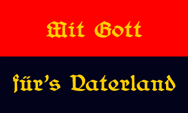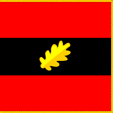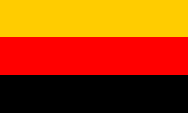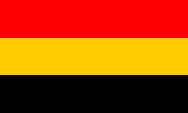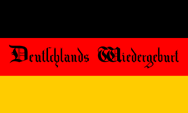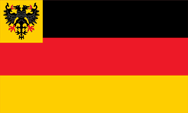Der Ursprung der schwarz-rot-goldenen Flagge
|
|
| Die Farbkombination Schwarz, Rot und Gold geht weit in die Geschichte des Deutschen Reiches zurück. Das Wappen des Heiligen Römischen Reiches Deutscher Nation zeigte einen schwarzen Adler auf goldenem Grund, dessen Fänge und Schnabel ab dem 13./14. Jahrhundert rot eingefärbt wurden. Ältestes Zeugnis dafür ist die um 1300 geschaffene "Heidelberger Liederhandschrift Manesse".³ | The
combination of the colours black, red and gold goes far back in the history
of the German Empire. The coat of arms of the Holy Roman Empire of German
Nation showed a black eagle on golden ground. Its claws and the beak were coloured in red since the 13th/14th century. Oldest witness for that is the ca. in 1300 created "Heidelberg Song Manuscript Manesse".³ |
| Bereits im Jahre 1184, auf dem Hoftag zu Mainz, sollen die Farben Schwarz, Rot und Gold als die "Deutschen Farben" bezeichnet worden sein.³ | Already in the year 1184, on the Hoftag (court day) in Mainz, the colours black, red and gold should have been named as "German Colours".³ |
| Als der Staufer Friedrich I. "Barbarossa" im Jahre 1152 in Frankfurt zum Deutschen König gekrönt wurde, soll der Weg zum Ort der Krönung auf Wunsch der Staufer mit einem eigens dafür angefertigten Teppich in Schwarz, Rot und Gold ausgelegt worden sein. Nach der Krönung soll der Teppich in kleine Teile zerschnitten und als Andenken im Volk verteilt worden sein.³ | As the
Staufer Frederic I. "Barbarossa" was crowned in the year 1152 in Frankfurt
to the German King, the way to the place of coronation should have been
floord on desire of the Staufers with an expressly for that prepared carpet
in black, red and gold. After the coronation the carped should have been cutted up in small pieces and given to the people as keepsake.³ |
| Im Jahre 1212 krönte Erzbischof Siegfried III. von Epstein im Dom zu Mainz den Staufer Friedrich II. zum Deutschen König. Dabei trug Friedrich einen Krönungsmantel in den Farben Rot, Schwarz und Gold. Dieser Mantel wurde für die meisten Krönungen der Deutschen Könige und Kaiser bis zum Ende des Heiligen Römischen Reiches Deutscher Nation (1806) verwendet.³ | In the year 1212 Archbishop Siegfried III. of Epstein crowned the Staufer Frederic II. to the German King in the cathedral in Mainz. Here Frederic weared a coronation coat in the colours red, black and gold. That coat was in use for the most coronations of the German kings and emperors until the end of the Holy Roman Empire of German Nation (1806).³ |
| Im Deutschen Bauernkrieg, einer antifeudalen Erhebung in den Jahren 1524/1525, versammelte sich in der Landgrafschaft Stühlingen im Schwarzwald eine Schaar von 800 Bauern zum Kampf unter eine Fahne in den Farben Schwarz, Rot und Gold.³ | In the German Pawn War, an anti-feudal revolt in the years 1524/1525, 800 farmers assembled for the fight in the County of Stuehlingen in the Schwarzwald Area under a banner in the colours black, red and gold.³ |
| In den Freiheitskriegen gegen Napoléon gründete Ludwig Adolf Wilhelm Freiherr von Lützow (1782–1834), ein preußischer Offizier im Range eines Majors, im Februar 1813 das Lützowsche Freikorps, auch "Lützower Jäger" oder "Schwarze Schar" genannt. Diese militärische Einheit wurde aus freiwilligen Kämpfern aus verschiedenen deutschen Staaten rekrutiert, und galt somit als Avantgarde eines national inspirierten Volksheers. Zwei Drittel der Lützower Jäger kamen aus den Rheinbund-Staaten und aus Tirol, ein Drittel waren Preußen.² | In the Freedom Wars against Napoléon founded Ludwig Adolf Wilhelm Baron von Luetzow (1782–1834), a Prussian military officer in rank of a major, in the February of the year 1813, the Luetzow Free Corps, named also "Luetzow Hunters" or "Black Bevy". This military unit was recruited from voluntary fighters from different German states, and was in this way the vanguard of a national inspired people's army. Two thirds of the Lutzow hunters came out of the Confederation of the Rhine States and from Tyrol, one third were Prussians.² |
| Das Lützower Freikorps hatte eine Fahne, die nicht im Gefecht oder in der Marschordnung gezeigt wurde (leichte Truppen hatten in Preußen bis Ende 1815 gar keine Fahne), sondern nur zu Zwecken der Anwerbung. Sie zeigte zwei Streifen in Rot und Schwarz, und die Inschrift "Mit Gott für's Vaterland". Diese Fahne hing im jeweiligen Werbe-Büro des Freikorps an der Wand, und zwar oberhalb des Tisches, auf dem der neue Angeworbene seine Unterschrift leistete. Sie hing zuerst im Breslauer Gasthaus "Zum Goldenen Szepter" und dann immer dort, wo die Lützower gerade Halt machten und neue Kämpfer anwarben. Das machte diese Fahne sehr bekannt. So ist die optische Gestaltung der Jenaer Burschenschaftsflagge von 1816 sehr gut nachvollziehbar.² | The
Lutzow Corps had a banner, that was not shown in combat or in the order of
march (light troops hab in Prussia to the end of the year 1815 no own flag),
but only for purposes of recruitment. It showed two stripes in red and
black, and the inscription "With God for the Fatherland".
This banner
hung on the wall in the relevant recruitment bureau of the corps, actually
above the table on which the new recruit contributed his signature. It hung
first in Breslau in the Inn "At the Golden Scepter" and then wherever the
Luetzow Free Corps just halted and enlisted new fighters. |
| Das Korps
war zwar Teil der regulären preußischen Armee, gehörte jedoch nur zur
leichten Infanterie der Linie, aber es wurde zu bestimmten Zwecken
herangezogen, so z.B. für Guerillataktik, Gewaltsame Aufklärung, Verfolgung
und für Streifzüge. Dabei hat es sich gut bis sehr gut bewährt, z.B. vor
Bremen und an der Göhrde. Für diese Verdienste wurde das Korps nach der Abdankung Napoleons 1. (1814) in die reguläre Linie übernommen. Die Lützower Infanterie wurde zum 25. Infanterie-Regiment, die Lützower Kavallerie zum 6. Ulanen-Regiment und die Lützower Artillerie zur Reitenden Batterie Nr. 14.² |
However,
the Corps was indeed part of the regular Prussian army, but it only belonged
to the light infantry of the line, but it was used for specific purposes,
such as for guerrilla tactics, forcible reconnaissance, pursuit and for
outings. It has been proven well or even very good, for example near Bremen
and at the Goehrde River. For these merits the corps was adopted into the regular line of the Prussian army, after the abdication of Napoleon (1814). The Luetzow Infantry became the 25th Infantry Regiment, the Luetzow Cavalry became the 6th Ulanen Regiment and the Luetzow Artillery became to the Horse-Battery No. 14.² |
| Karl-Theodor Körner (1791–1813) feierte das Korps in seinem Gedicht "Lützows wilde, verwegene Jagd", und machte ihre schwarze Uniform mit den roten Aufschlägen und goldenen Knöpfen, mit den schwarzen Mützen und der schwarz - rot - goldenen Kokarde darauf, sehr populär.² | Karl-Theodor Koerner (1791–1813) celebrated this corps in his poem "Luetzow's wild, audacious hunt", and made their black uniform with the red cuffs and golden knobs with the black caps and the black-red-golden cockade very popular.² |
| Später trugen in der thüringischen Stadt Jena viele ehemalige Lützower ihre Waffenröcke als studentische Bundeskleidung ihrer Burschenschaft. Die Burschenschaft benötigte eine Flagge, und so schuf Amalia Nitsche im Jahre 1816 eine Flagge, welche, von der Kleidung der Studenten inspiriert, erstmals die Farben Schwarz, Rot und Gold zeigte. Die Flagge zeigte drei waagerechte Streifen in den Farben Rot, Schwarz und Rot, und der schwarze Mittelstreifen trug ein goldenes Eichenlaub. Die Farben Schwarz, Rot und Gold gingen allmählich über die studentische Verbreitung hinaus und standen in ganz Deutschland für nationale und republikanische Kreise, welche die deutsche Kleinstaaterei und ihre Monarchien überwinden wollten. Beim noch von Studenten geprägten Wartburgfest im Jahre 1817 (durchgeführt zur Erinnerung an die Reformation und die Völkerschlacht bei Leipzig) und beim Hambacher Fest im Jahre 1832, welches nun schon von breiten Kreisen der Bevölkerung getragen wurde, wurden erstmals schwarz-rot-goldene Flaggen gezeigt, jedoch in unterschiedlichen Anordnungen der Streifen. | In the
afteryears many former Luetzow Hunters weared their uniforms as a student
fellowship outfit in the Thuringian town Jena . The fellowship needed a flag, and in this way Amalia Nitsche created a flag in the year 1816, which, inspired by the outfit of the students, showed for the first time the colors black, red and gold. This flag showed three horizontal stripes in the colors red, black and red, and the black middle stripe carryed a golden oak leaf. The colors black, red and gold gradually spread out over the student propagation and stood in whole Germany for national and republican circles, which want to outgrow over the splitted German small states and their monarchies. At the only by students characterized Wartburg Festival in the year 1817 (performed to remember the Reformation and the Leipzig Battle of Nations) and at the Hambach Festival in the year 1832, which now was already supported by wide circles in the population, were showed for the first time black-red-golden flags, however in different arrangements of the stripes. |
Als
mögliche Motive für die Übernahme der Farben Schwarz, Rot und Gold als
gesamtdeutsche Farben gelten folgende Theorien:
|
As
possible motives for the adoption of the Farben colors black, red and gold
as all-german colors count the following theories:
|
| Als es in
Deutschland ab März 1848 zur bürgerlichen Revolution kam, wurde die
schwarz-rot-goldene Flagge zur Flagge der aufständischen Bürger. Nach
ergebnislosem und sinnlosem Blutvergießen lässt Friedrich Wilhelm IV., König
von Preußen, das Militär aus Berlin abziehen und begibt sich am 21.03.1848
mit einer schwarzrotgoldenen Armbinde auf einen Umritt, um seinen Willen zu
Zugeständnissen zu zeigen, und das Blutvergießen zu beenden. Die schwarz-rot-goldene Flagge zierte dann im Mai 1848 die Eröffnung der Nationalversammlung in der Frankfurter Paulskirche und wurde schließlich als Nationalflagge angenommen. Bundesbeschluss über Wappen und Farben des Dt. Bundes (hier klicken). Nach dem Scheitern der Revolution und der Auflösung der Nationalversammlung wurde die Flagge im Jahre 1850 als gesamtdeutsches Symbol vom preußischen König verboten, obwohl sie noch 1864 im deutsch-dänischen Krieg auf österreichischer Seite zum Einsatz kam. |
When it
came in Germany from March 1848 to the bourgeois revolution, the
black-red-golden flag became the flag of the rebellious citizens. After fruitless and senseless bloodshed Friedrich Wilhelm IV., King of Prussia, lets remove the military from Berlin and went on a rode round on 21st of March in 1848 with a black-red-golden armband to show his will to make concessions, and to end the bloodshed. The black-red-gold flag graced then, in May 1848, the opening of the national assembly in the Pauls Church in Frankfurt and it was finally adopted as the national flag. Federal Act about Coats of Arms and Colours of the German Confederation (only in German language, click here) After the failure of the revolution and the dissolution of the national assembly the flag became banished as all-german symbol in the year 1850 by the Prussian king, although it was in use by the Austrian troops in the year 1864 in the German-Danish War. |
| Im Deutschen Krieg von 1866/67 (auch preußisch-österreichischer Krieg oder Bruderkrieg genannt) trugen die Truppen des Bundesarmeekorps teilweise schwarz-rot-goldene Armbinden. Nicht zuletzt deshalb empfand man in Preußen die Farben Schwarz, Rot und Gold als die Farben des Feindes.² | In the
German War of 1866-67 (also alled Prussian-Austrian War or Fratricidal War)
the troops of the Federal Army Corps weared partly black-red-golden
armbands. Not least because of that fact the colors black, red and gold were felt in Prussia as the colors of the enemy.² |
| Nach dem
Sieg Preußens im Deutschen Krieg gingen die Initiativen zur Einigung des
Reiches von Preußen aus, so dass der Norddeutsche
Bund, und später auch das Deutsche Reich
(1871) keine schwarz-rot-goldene, sondern eine schwarz-weiß-rote Flagge
einführte. Fürst Bismarck sprach dazu im Jahre 1871: "Meinetwegen Grün und
Gelb und Tanzvergnügen oder auch die Fahne von Mecklenburg-Strelitz. Nur
will der preußische Troupier (gemeint war der spätere Kaiser Wilhelm I.)
nichts von schwarz-rot-gelb wissen."² Erst nach der erfolgreichen bürgerlichen Revolution des Jahres 1918 kam die schwarz-rot-goldene Flagge wieder zu Ehren, und wurde am 11.08.1919 als Nationalflagge des Deutschen Reiches eingeführt. Am 13.03.1933 wurde die schwarz-rot-goldene Flagge durch die Nationalsozialisten wieder abgeschafft. |
After
Prussia's victory in the German War the initiatives for the unification of
the empire came from Prussia, so that the North German Confederation and later even the German Empire did not introduce a black-red-golden
but a black-white-red flag. Bismarck so spoke to in 1871: "If you like, green and yellow, and dances, or the flag of Mecklenburg-Strelitz. But the Prussian Troupier (he meant the future Emperor Wilhelm I.) wants nothing to do with black, red and yellow."² Not until the successful civic revolution of the year 1918 the black-red-golden flag came to honors again, and was introduced on 11th of August in 1919 as national flag of the German Empire. On the 13th of March in 1933 the black-red-golden flag was abolished by the national socialists again. |
| Quelle/Source: Volker Preuß, (2) Jürgen Kaltschmitt, (3)Deutschlandfunk | |
